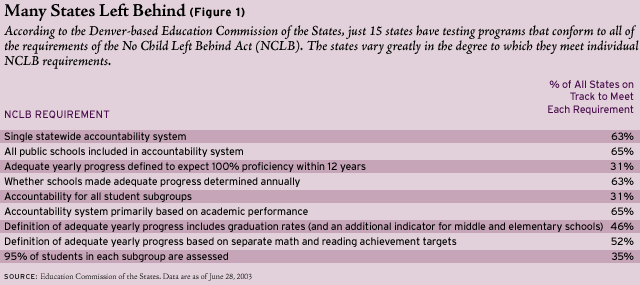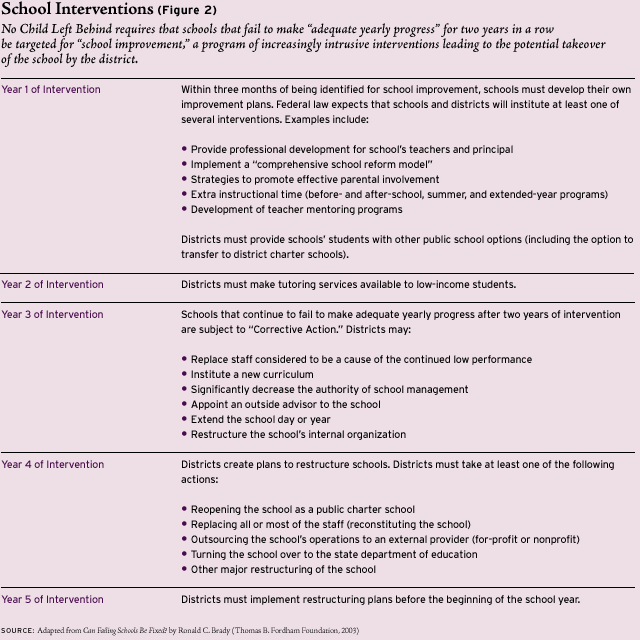
In January 2002, President George W. Bush signed a comprehensive revision of the Elementary and Secondary Education Act of 1965. Known popularly as the No Child Left Behind (NCLB) Act and passed with strong bipartisan support in Congress, this new legislation promises an important shift in efforts at all levels to improve the quality of public education. Integral to its purpose is an array of tough-minded mandates governing student assessment and school accountability.
Though the federal government is the driving force behind NCLB, the states will ultimately be responsible for its outcome. A critical provision requires every state education department to develop and implement an annual accountability plan. Beginning with the 1994 reauthorization of the Elementary and Secondary Education Act, each state was required to devise a substantive definition of the skills and knowledge that a child should learn in each grade. States were then to develop tests to examine whether schools and students are meeting the standards. Starting with the 2005-06 school year, NCLB requires that states administer reading and mathematics tests annually in grades 3 through 8. By 2007-08 states will need to assess achievement in science as well. Within 12 years, states are expected to have all their students performing at an academically proficient level in core subject areas.
Each state, district, and school under NCLB will be expected to register “adequate yearly progress” toward meeting these goals. Progress is to be measured both for all students and for students disaggregated into various subgroups, including disadvantaged students, those with limited English proficiency, students with disabilities, and those from racial or ethnic minority populations.
School performance will be publicly reported via state, district, and school “report cards.” Schools that do not achieve adequate yearly progress will be subject to increasingly stringent sanctions-notifying all parents of the failure, allowing students to switch schools, and ultimately reorganizing under new leadership. Districts failing to make adequate progress face similar sanctions imposed by states.
Meeting these requirements will pose a major challenge for states lacking much experience with accountability. A recent Education Commission of the States report indicates that just 15 states currently have testing programs that conform to the new requirements (see Figure 1). Many more lack the infrastructure needed to support the level of data collection, disaggregation, and reporting that the new law requires.

Achieving full compliance with the new law may prove a less formidable task in states like Texas and North Carolina, where mature accountability systems are already in place. However, already having some type of accountability structure in place could turn out to be a mixed blessing. In some cases, the challenge may be to sustain whatever public acceptance a previous statewide accountability effort has garnered while making the changes necessary to make it compliant with the new federal guidelines.
The Education Commission of the States has developed a unique database that identifies the extent to which each of the 50 states is meeting the law’s requirements. Using the database, we calculated a national average score for NCLB compliance and then assigned each of the 50 states to one of three categories: 1) high-readiness, 2) mid-readiness, and 3) lower-readiness. From these three groupings, we selected three high-readiness states, two mid-readiness states, and three lower-readiness states as case studies. Florida, New York, and Texas fell into the first category; California and South Carolina represented the second; and Missouri, New Hampshire, and Washington the third. Collectively these eight states educate more than 18 million children, nearly 40 percent of the country’s school population.
In an effort to identify where individual states are situated as they attempt to conform to the new legislation, we conducted informal, open-ended, structured interviews with key policymakers in each of these states. The aim was to understand their perceptions or estimations of their readiness for NCLB, to hear about the challenges they have confronted, their chief concerns, the degree to which popular support exists for enhanced accountability, opposition (if any) to statewide testing programs, and other salient features of each state’s situation.
| Education officials from states with more “mature” accountability systems expressed the most detailed reservations about the No Child Left Behind mandates. |
New Politics
Our sample of states ranges from Texas, which for obvious reasons was the inspiration for NCLB’s view of accountability, to New Hampshire, which has yet to even begin rating schools based on their performance. States like Texas and California have more than a decade of experience with assessment and accountability, while Missouri and New Hampshire have only recently been pulled into the standards-based reform movement by federal mandates.
Nevertheless, our interviews with state officials showed that policymakers are confident about their state’s ability to comply with the law, though some are more ready than others. Making things easier, state officials report, is the steady subsiding of organized group opposition to school accountability in most of these states. “The naysayers are falling off now and people are realizing that reform and accountability are good things,” said Rob MacGregor, Washington State’s assistant superintendent for school improvement. This partially reflects the fact that most states had accepted the ideas that schools should be held responsible for student performance and that results from standardized tests should play a large role in determining consequences (to view the consequences for schools failing to make adequate yearly progress, see Figure 2). Consider that before the passage of NCLB, 30 states had already developed and implemented statewide school rating programs that were in place during the 2002-03 school year. Other states were in the midst of developing programs that will start up in the next year or two.

In states where accountability had yet to take root, the federal legislation seems to have changed the political landscape. For example, in New Hampshire, a state with a long history of local control, legislators had failed on several occasions to pass accountability legislation. NCLB speeded things along immensely. By early 2003, state officials had proposed accountability legislation that passed the state senate and as of May was under consideration by the state house of representatives’ finance committee. Once enacted, it was expected to open the door for the development of a true statewide accountability system. Paul Ezen, deputy commissioner for the New Hampshire Department of Education, says that NCLB supported the direction “that both the state board and the legislature have been trying to go in the past.”
In other states, NCLB has in a strange way brought local and state-level policymakers together. For example, teacher groups in California had previously voiced discomfort with the state’s accountability program and Academic Performance Index for all schools. Now, with the requirements of NCLB looming, many one-time critics express their affection for the performance index. To some extent, federal policymakers are playing the “bad guy,” making state-level requirements appear far more reasonable in those states with longstanding accountability systems.
Of course, not everyone is breaking bread, and opposition is coming from some surprising sources. In New York, well-publicized boycotts of state tests have been organized in wealthy, high-performing suburbs of New York City like Scarsdale. In South Carolina, too, Jo Anne Anderson, executive director of the South Carolina Education Oversight Committee, reports, “We still get most of our grumbling from suburban systems that expect higher ratings than the system shows.” Ira Schwartz, New York State’s coordinator for administrative accountability and policy, contrasted suburban opposition with support from large urban districts, which he felt welcomed an accountability system that gave them “an opportunity to demonstrate their progress and some of their successes, even though they are the ones that typically have the most schools at risk.”
Nonetheless, widespread support for accountability could crumble under the increasing financial pressures facing the states. Nearly all of the officials we spoke with expressed strong concerns that NCLB demands increased expectations and efforts at a time when districts are experiencing budgetary shortfalls and even staff reductions. Nowhere was this problem more evident than in New Hampshire, which boasts a well-known state law forbidding “unfunded mandates.” The school superintendents association has published a widely disseminated report highlighting the “hidden costs” of NCLB, estimating that for every $70 of federal funds coming in, it would cost $570 of state monies to comply with the law. “You can’t mandate anything without paying for it,” says New Hampshire’s Ezen. “That’s going to be a real trigger for us. I think if the [hidden] cost issue continues to eat away at people, that may be the stumbling block.”
Officials in other states hypothesized that reluctant educators have thus far cooperated with accountability requirements in return for the promise of financial assistance for both high-performing and low-performing schools. However, if the state is unable to deliver its end of the bargain, support for accountability is likely to suffer.
| Making things easier, state officials report, is the steady subsiding of organized group opposition to school accountability in most of these states. |

Protests
Support for NCLB is by no means universal among state officials. Interestingly, it was the education officials from states with more “mature” accountability systems who expressed the most detailed reservations about NCLB. While policymakers in some states struggle to get their assessments and ratings systems off the ground, high-readiness states worry about technical issues related to schools’ ability to meet their targets for adequate yearly progress. For instance, officials in Florida, a high-readiness state where the “A+ Accountability System” doles out vouchers to students in low-performing schools, doubt that states can meet NCLB’s long-term proficiency goals. John Winn, Florida’s deputy commissioner for accountability research and measurement, says, “No Child Left Behind has to change. . . . The biggest disconnect that has to be addressed is this expectation of 100 percent proficiency after 12 years.” Florida, he noted, is a rapid-growth state, experiencing a constant influx of immigrants lacking English proficiency. The expectation that schools can achieve complete proficiency under conditions that are by no means under the state’s control is unrealistic. For Winn, a better alternative would be to base accountability not on a student’s academic “status” at any one point in time, but instead on documented “growth” in achievement.
While Bill Padia, director of the policy and evaluation division at the California Department of Education, thinks California’s state accountability plan is “relatively close” to full NCLB compliance, he too reports that California educators are skeptical of a system where “you just raise the bar every year and the bar will be up at 100 percent in 12 years.” Of special concern are simulations showing that within five to six years, practically every school in the state would fail to meet the progress requirement. “If you’re going to tell 89 to 95 percent of the schools that you’re not making it,” says Padia, “what good is it to have accountability?” Striking a similar note, South Carolina education official Jo Anne Anderson asked, “Will people just roll their eyes and see it as a meaningless expectation, or will they really roll up their sleeves and think we’ve got to do something about this?” Given the potential for large numbers of schools to fall short of adequate yearly progress goals in many states, several officials questioned the viability of the school choice provisions of NCLB. After all, if nearly all schools in California are labeled as failing in a few years, what choices will the students and parents have?
Officials in low-readiness states expressed some concerns about these issues as well. Rob MacGregor of Washington State presides over a system that, while it has assessments in place, does not formally rank all of the schools in the state-only the low performers are identified. Yet he still harbors doubts about NCLB’s long-term prospects, at least in its current form. “Based on the idea that a school has to fail to meet [progress goals] for two consecutive years, we can project that . . . we’ll probably have 90 schools in school improvement next year. Then, the following year, there will probably be 450 or more. And we may have more in the coming years.” He said it was possible that a rigorously enforced NCLB would drive people out of their careers in education. “I hope we don’t have good people leaving the profession,” he remarked.
| Already there is evidence that federal officials are not holding the line on key requirements of No Child Left Behind. |

Tripped Up
One challenge that officials in high-readiness states routinely cite is their ability to change mature accountability systems that took years of hard-fought political battles to create. Such officials oversee systems with well-established regulations and procedures and are understandably reluctant to overhaul them. They are also concerned that asking teachers to buy into yet another shift in policy will undermine the credibility of state department of education officials themselves. “All that we ask,” said New York official Ira Schwartz, “is that we be given sufficient flexibility so that we can meet the spirit of No Child Left Behind without having to dismantle what we think is, and what has been judged by others to be, a very effective system of standards, assessment, and accountability.”
There could be many circumstances, officials noted, in which schools that score high on state systems fail to meet NCLB’s requirements for progress. One of the key reasons for a possible disconnect is the law’s requirement that not only the entire school but also racial, ethnic, economic, and other subgroups within the school make adequate yearly progress. This method of calculating a school’s progress has been referred to as a “trip wire” system, in which poor performance by one subgroup in one subject area can “trip up” an entire school. Paul Ezen of New Hampshire asked, “Is the special ed population in the school going to throw a school into [adequate yearly progress] failure when the majority of the student body is making the goal?” According to NCLB, the answer is yes, and this worries many policymakers. They believe that progress among all student subgroups in a school is an important goal, but that this measure of performance is bound to be problematic, especially in an ethnically diverse state like California, where subgroups within a school can number in the double digits. In such circumstances, it is difficult to avoid statistical “mischief” and false negatives because test scores can bounce around from year to year for reasons other than genuine changes in student achievement.
One subgroup that has raised particular concern is students with limited English proficiency (LEP). Criss Cloudt, associate commissioner for accountability reporting and research in the Texas Education Agency, said, “The problem with the LEP group is that, once those students become proficient, they exit the group.” The natural question is, how will that subgroup of students meet the performance targets when students who score at proficient levels are quickly taken from the group?
A related concern of policymakers is whether federal officials will get involved in the setting of proficiency levels. A clear incentive exists for states to set these levels low so as to avoid failure on the scale noted above. The state officials we interviewed indicated that their states had high proficiency standards and were not likely to lower them simply to increase their chances of meeting federal guidelines. However, the possibility of this type of gamesmanship is real and should be watched carefully.
In addition, a few states that have embraced accountability have the technological capacity to assess schools’ performance on the basis of the degree to which individual students improve each year. For example, a few states use longitudinal growth models that, in as careful a way as possible, measure the “value added” by a given school in the course of a year. Clearly, such a model does a better job of measuring school “effectiveness” than a model that simply provides a snapshot of the percentage of students scoring above a given benchmark. Ironically, however, it is not clear that these growth models would fulfill the more simplistic federal requirements for adequate yearly progress, which dictate that the performance of students at each grade level be measured against a fixed standard of proficiency. Should these states have to discard their existing system and move toward one that is more likely to fulfill federal requirements but is less desirable according to most experts in testing and measurement? Of particular concern are states such as North Carolina that use scaled scores to measure students’ academic growth longitudinally across the entire spectrum of student performance. Would we want to discourage a system that provides incentives to pay attention to students at all levels of proficiency in favor of one that might encourage educators to focus exclusively on those students near proficiency cutoff scores?
In California, Padia reports, a consensus has emerged in favor of trying to make NCLB work, but without necessarily sacrificing valuable features of the state’s existing accountability system. However, with regard to adequate yearly progress, state officials do not expect a great deal of flexibility from federal officials and have conceded that their current accountability measure, the Academic Performance Index, is not likely to meet federal regulations. As a result, California intends to overlay federal requirements onto its own system.
Bert Schulte of Missouri’s Division of School Improvement predicts that his state will make adequate yearly progress simply another indicator of school performance within the present accountability system. The aim, Schulte explained, is “to marry what we’re doing with the No Child Left Behind expectations as fully as possible . . . and not let the No Child Left Behind process serve as a trump card that overrides a lot of the things that we already have in place.”
A common perception in education circles is that there is no need to take any particular reform effort too seriously, if only because in short order it will be supplanted by something else. If this is not to be NCLB’s fate, some measure of accommodation from the federal government will be critically important. State education officials-many of them, at any rate-have labored diligently to persuade teachers and school administrators (groups typically not strongly in favor of testing initiatives) to support the strengthening of accountability measures. Care must be taken, then, not to interpret and apply NCLB in ways that diminish the credibility of its strongest supporters. Remember that some of the gravest concerns come from officials in states like Texas, New York, and Florida-states that are already the vanguard of the accountability movement. It seems important that their efforts not be inadvertently thwarted by the imposition of federal strictures they simply cannot accommodate. As Texas’s Criss Cloudt put it, “I’m hoping [federal officials] will find some ways to give . . . states greater flexibility, particularly those that have a demonstrated track record of holding schools accountable.”
While flexibility is key to the successful implementation of No Child Left Behind, states must remain true to the law’s intent. So far, the news is mixed on this front. The good news is that, in a Rose Garden press conference held on June 10, President Bush celebrated the approval of all the states’ accountability plans. Each plan outlines how the state will meet the requirement for adequate yearly progress, leading to the ultimate goal of 100 percent proficiency by the year 2012.
Whether these plans will leap from paper to practice remains to be seen. But already there is evidence that federal officials are not holding the line on key NCLB requirements. Iowa, for example, still has no statewide academic standards or benchmarks. If the Department of Education is not defending No Child Left Behind at the planning stage, what will happen when it comes time to enforce its full-scale implementation? Moreover, if federal officials are seen as being flexible with states that ignore the spirit of the law, while officials in other states are dutifully modifying long-existing accountability programs to conform with the technical details of NCLB, much credibility will be lost.
-Gary W. Ritter is an assistant professor of education and public policy, and Christopher J. Lucas a professor of education, at the University of Arkansas.


